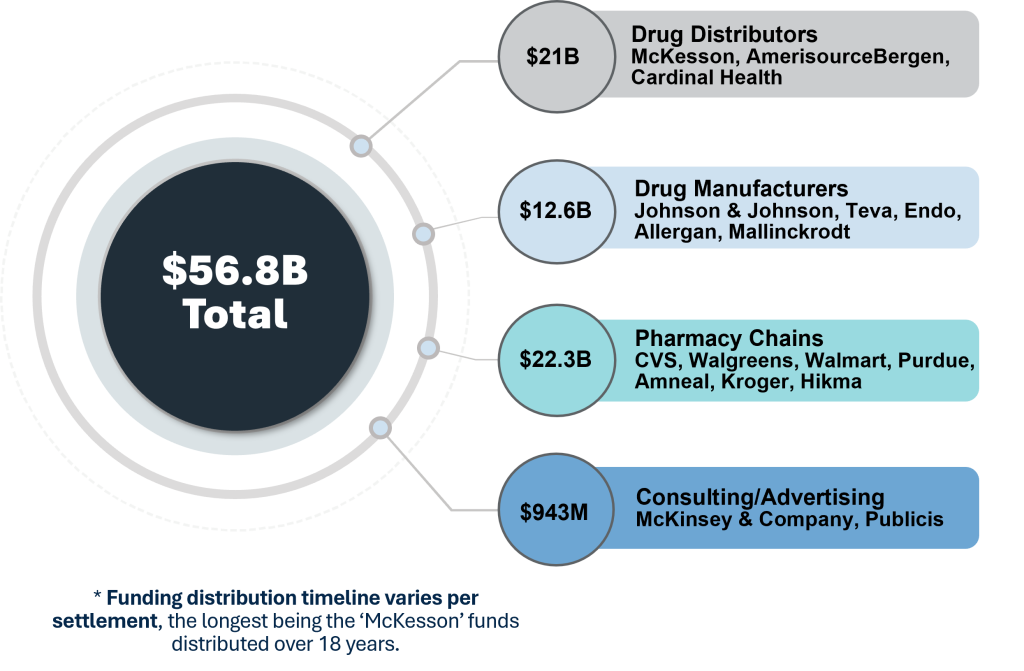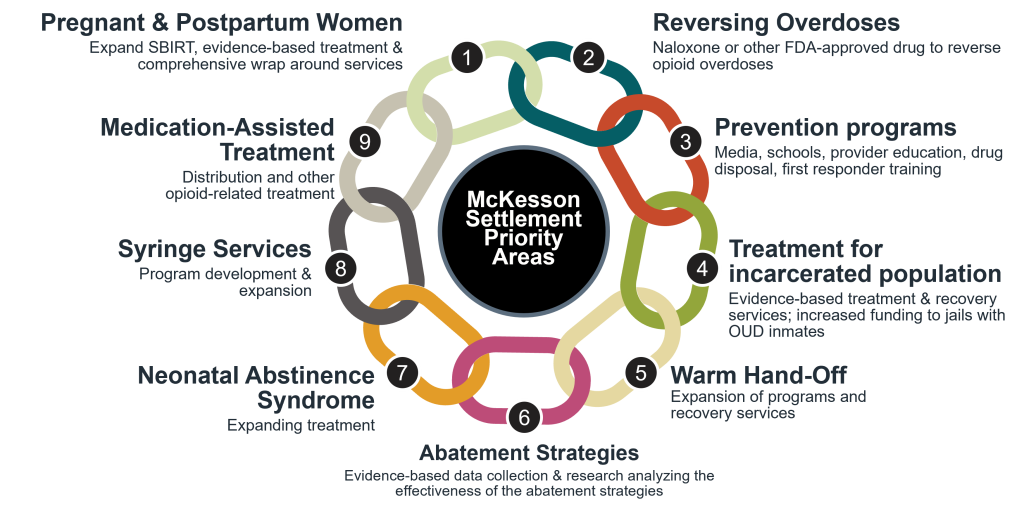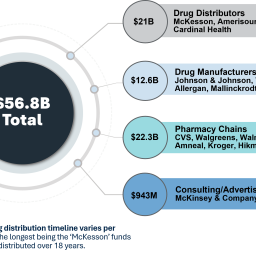A Look Back to How the Opioid Crisis Began
The roots of the opioid crisis trace back to the 1990s, when prescription opioid medications such as OxyContin were increasingly marketed and prescribed to manage pain. From 1999 to 2010, opioid sales in the United States quadrupled, contributing to a steady rise in opioid use nationwide. According to a 2022 report from the Congressional Budget Office (CBO), 565,000 Americans died of opioid-involved overdoses between 1999 and 2020.
What are the Opioid Abatement Settlements?
In 2021, 46 states and the District of Columbia participated in a class action lawsuit against pharmaceutical distributors McKesson, Cardinal Health, and AmerisourceBergen collectively (known as the McKesson settlement), as well as a separate lawsuit against Johnson & Johnson, for the role each company played to fuel the opioid crisis.
These two lawsuits led to $26 billion in nationwide settlement agreements, requiring the distributors and manufacturers to stop selling opioids, and stop promoting or lobbying on activities related to opioids, among other obligations. Since 2021, various other opioid manufacturers, distributors, pharmacy chains, and consulting/advertising firms have reached similar settlement agreements, totaling over $50 billion in funds to be allocated to support local opioid crisis remediation efforts via state and local governments.

State Allocation of Funds Differs State by State
All 50 states, DC, and Puerto Rico are entitled to a portion of these funds through several different litigation settlement points of entry. Each state will receive annual funding from the opioid settlements, with allocation based on population and determination of the relative degree of harm suffered in the community as a result of the opioid epidemic.
Oversight of funding allocation differs state by state, with distribution of funds often administered through Attorneys General’s offices and local county governments. State or local programs may differ on what they consider priorities for usage of opioid settlement funds, which makes both the mechanism and approved uses of funding location-specific. Reporting requirements also vary by state.
How Are State Settlement Funds for Opioid Abatement Being Used?

source: https://www.attorneygeneral.gov/wp-content/uploads/2021/12/Exhibit-E-Final-Distributor-Settlement-Agreement-8-11-21.pdf
The original, and largest, McKesson opioid settlement agreement details a list of approved opioid remediation strategies, such as increased training on and distribution of Naloxone and other approved drugs to reverse overdoses; prevention and recovery programs; expanding treatment for Neonatal Abstinence Syndrome (NAS); Medication-Assisted Treatment (MAT) distribution; Screening, Brief Intervention, and Referral to Treatment (SBIRT) for pregnant and postpartum women; and more.
Some states have begun releasing annual reports showing overviews of projects that have been funded through Opioid Settlement funding. Some examples are as follows:
- $262,000 in start-up funding for a recovery transitional housing facility for those with a dual diagnosis of substance use and mental health disorders in Batholomew, Indiana.
- $99,000 to the Department of Military and Veteran Affairs in Pennsylvania for the purchase of a mobile waste incinerator unit to support drug take back proposals and destruction programs.
- $549,858 to the Ho-Chunk Nation in Wisconsin to support locally determined needs related to prevention, harm reduction, treatment, and recovery services.
- $350,000 for the Vermont Department of Health to study overdose prevention centers.
- $300,000 for a collaborative project between Prisma Health and Clemson University in South Carolina to expand outreach and access to prenatal and maternal services for women with opioid use disorder, as well as their infants.
Applying for Opioid Settlement Funding
If you are an organization that is doing impactful education, prevention, or treatment work to combat the opioid crisis in your community, opioid settlement funding may be a good way to forge partnerships at the state and local level and access critical resources to further extend the reach of your organization’s impact. States are bound by law to make settlement funds available to community-based organizations and institutional partners for the next 15-plus years, representing an opportunity to participate in sustainable, longitudinal work.
McAllister & Quinn tracks and supports efforts to access opioid settlement funding for initiatives such as K–12 prevention programs, mobile treatment services, free naloxone distribution, and more. Since the start of national payouts in 2022, we’ve found that successful partnerships with counties or states often hinge on organizations clearly articulating their capabilities and past work, demonstrating how their work aligns with local priorities, and showing a commitment to being a long-term partner in combating the opioid epidemic.
Evidence-based initiatives that have been demonstrated to work should be the main focus of an applicant’s proposal, as jurisdictions largely want to implement corrective strategies that are proven to lead to positive outcomes as opposed to testing out strategies that may not work or may even be counterproductive.
States and localities also are guided by national opioid settlement principles that direct them to focus on racial equity, as marginalized populations are often more severely affected by overdose deaths. Utilizing settlement funds to address racial or other disparities may help support institutions and communities which have in the past relied on federal funding that is currently in question for health equity initiatives.
About McAllister & Quinn: Founded in 2004, McAllister & Quinn is a D.C.-based full-service government affairs and external funding consulting firm with deep expertise in strategic consulting and proposal development for competitive federal and non-federal grants, Congressionally Directed Spending requests, and complex government procurements.
Our services include full proposal development—writing, editing, and organizing technical responses, executive summaries, methodologies, and reviewing budgets—while ensuring strict adherence to each funding entity’s compliance requirements and with an astute focus on positioning our client as the most capable institution to help the government entity or private funder address the unique challenges that they are looking to address. We work closely with our own internal subject matter experts (SMEs) as well as those of our clients to integrate their knowledge effectively, and we offer strategic guidance to strengthen content and increase the likelihood of success.






